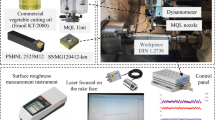Abstract
A method based on thermal gravimetric analysis (TGA) was developed to evaluate the chemical properties of particleboard causing high-temperature corrosion (HTC) of cemented carbide tool material. A descriptor (R MSMI) characterizing HTC of material machined on the tool material was established and proved. The analysis of the relation between cutting edge wear (VB W) and cutting conditions, including corrosive properties and the chemical composition of the tool material used, resulted in a multifactor statistical model. An improvement of cemented carbide composition for milling particleboard is proposed. An attempt to analyze a synergistic effect (SE) between HTC and mechanical wear while particleboard milling was performed.










Similar content being viewed by others
References
Bock A, Schubert WD, Lux B (1992) Inhibition of grain growth on submicron cemented carbides. Powder Metall Int 24:20–26
Bridges RR (1971) A quantitative study of some factors affecting the abrasiveness of particle board. For Prod J 11:39–41
Boehme C, Münz U (1987) Zerspanungsverhalten u Vreschleisswirkung von Normal- und Sonderplatten mit einheitlicher Beschichtung bei Anwendung unterschiedlicher Zerspanungs- verfahren. Fraunhoffer- Institut für Holzforschung, WKI-Bericht 17:106
Kotlyar D, Pitt CH, Wadsworth ME (1988) Simultaneous corrosion and abrasion measurements under grinding conditions. Corrosion 44:221–228
Mouseev A V (1981) Iznostoikost derevorezhushchego instrumenta. Lesnaja prom, Moscow, p 111
Neusser H, Shall W (1970) Beitrag zum Porblem der Werkzeugsabnutzung bei Bearbeitung von Spanplatten und halbharten Faserplatten. Holzforschung und Holzverwertung 6:1–7
Porankiewicz B (1988) Mathematical model of edge dullness for prediction of wear of wood cutting tools. In: Proceedings of 9th wood machining seminar (WMS), UC Forest Products Laboratory, Richmond, USA, 1988:83–88
Porankiewicz B (1993) Does exist the chemical corrosion of carbide cutting edge when milling particle board? Ann Agricultural Univ Poznań CCXLIX:59–69
Porankiewicz B (1997a) Variation in composition of micro-grain cemented carbide, and its impact on cutting edge wear during particle board machining. In: Proc of 13th IWMS, Vancouver, Canada pp 791–799
Porankiewicz B (1997b) The simulation of high temperature corrosion of components of cemented carbide cutting edge in contact with particle board. In: Proc of 13th IWMS, Vancouver, Canada, pp 779 −790
Porankiewicz B (1998) Investigation of chemical wear of cemented carbide cutting edges by processing board materials. Project Report No. MR/USDA-95-219, p 32
Porankiewicz B, Grönlund A (1991) Tool wear—influencing factors. In: Proc of 10th IWMS, UC, Berkeley, USA, pp 220–229
Porankiewicz B, Wagner K (1997) The study of high temperature corrosion of cemented carbide cutting edge after coated particle board processing using advanced surface analyzing methods. In: Proc of 13th IWMS, Vancouver, Canada, pp 651–657
Stühmeier W (1989) Fräsen von Spanplatten mit hochharten Schneidstoffen. TU Braunschweig, F-B VDI R.2, no 181, pp 191
Wysiecki M (1997) Nowoczesne materiały narzędziowe. WNT, Warsaw, p 172
Acknowlegements
The paper was prepared on the basis of results of a project funded by the American–Polish, Maria Skłodowska-Curie II Fund in Warsaw and the Poznań Supercomputing and Network Center (PCSS). The author wishes to thank Dr. E. Chamot for reviewing the text.
Author information
Authors and Affiliations
Corresponding author
Rights and permissions
About this article
Cite this article
Porankiewicz, B. A method to evaluate the chemical properties of particleboard to anticipate and minimize cutting tool wear. Wood Sci Technol 37, 47–58 (2003). https://doi.org/10.1007/s00226-003-0166-8
Received:
Published:
Issue Date:
DOI: https://doi.org/10.1007/s00226-003-0166-8




